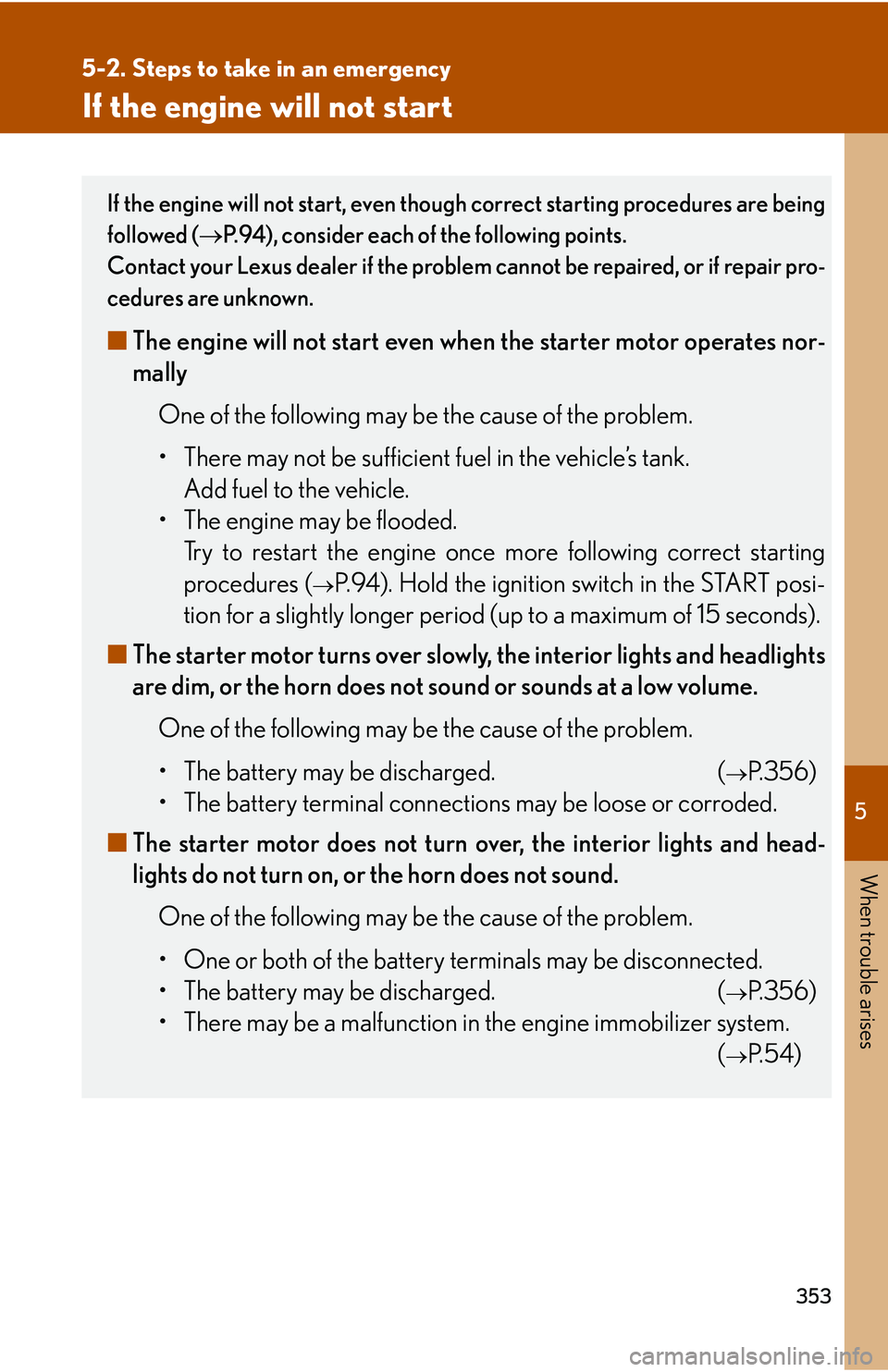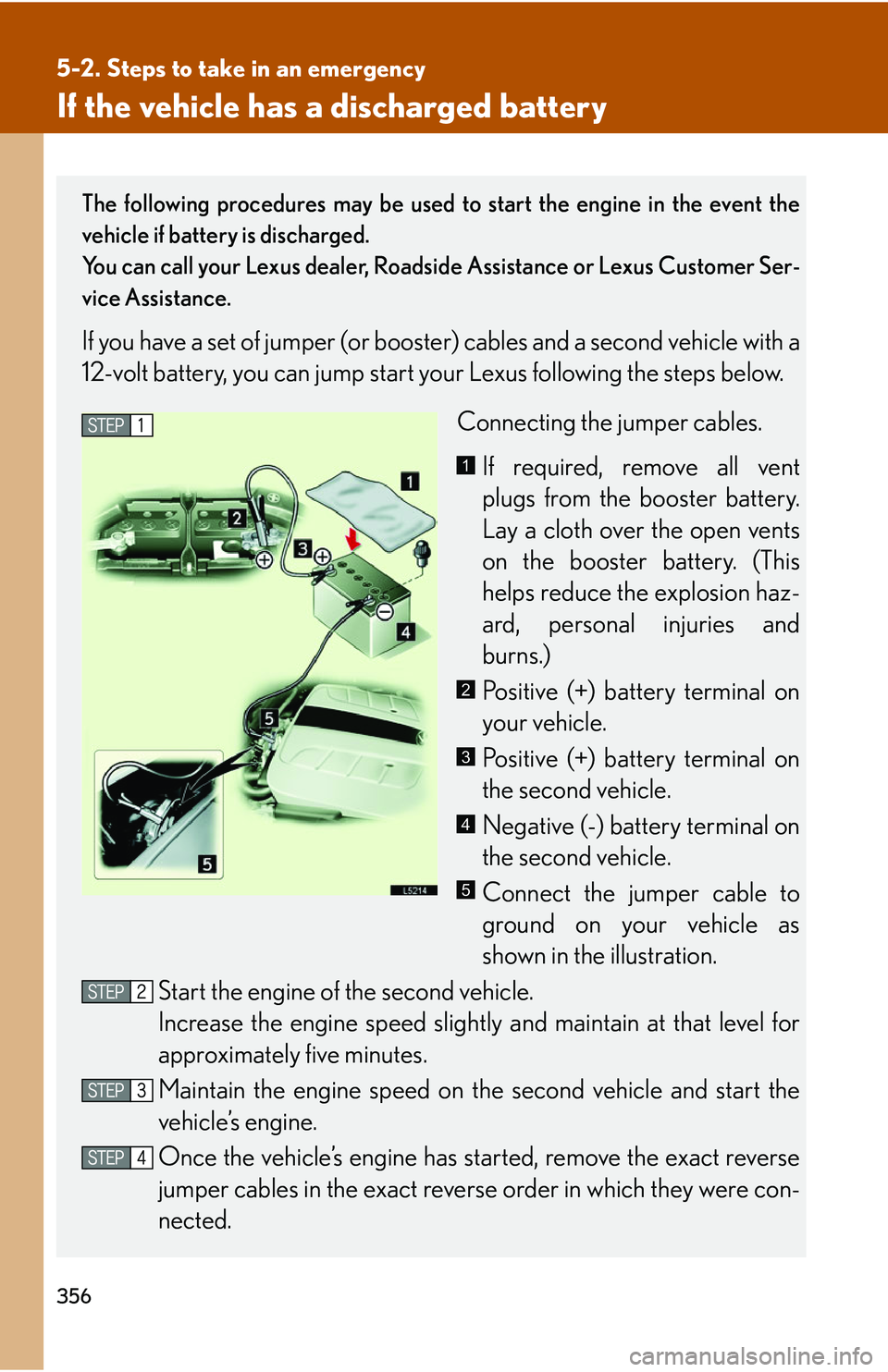Page 353 of 419
5
When trouble arises
337
5-2. Steps to take in an emergency
Have the malfunction repaired immediately.
After taking the specified steps to correct the suspected problem, check
that the warning message disappears.
Warning message and lightDetailsCorrection procedures
(flashes)
Engine oil level warn-
ing
The engine oil level is
low.Check the level of engine
oil and add if necessary.
Open door warning
(Warning buzzer)*1
Check that all doors are
closed.Indicates that a door
is not fully closed.
Graphic information
also appears to let
you know which
door is open.
Open trunk-lid warn-
ing
(Warning buzzer)*1
Indicates that the
trunk-lid is not fully
closed.Check that the trunk-lid
is closed.
Page 357 of 419
5
When trouble arises
341
5-2. Steps to take in an emergency
*1:Warning buzzer
A buzzer will sound and the master warnin g
light flashes if the vehicle is driven
at a speed of approximately 3 mph (5 km/h).
Warning message and lightDetailsCorrection procedures
Pre-collision system
warning
• The millimeter
radar sensor or the
grill cover is dirty.Clean the sensor cover
with a soft cloth.
• System turned off
for overheat pro -
tection because
pr
e-collision seat
belts have acti -
vated repeatedly
within a short time.
Wait for a while for the
system to reactivate.
Engine oil mainte -
nance information
(U.S.A. only)
The engine oil should
be replaced soon.
The engine oil needs
to be replaced.Replace the engine oil as
soon as possible.
Page 359 of 419
5
When trouble arises
343
5-2. Steps to take in an emergency
NOTICE
■While the engine oil level warning is displayed
Continued engine operation with low engine o
il will damage the engine.
■Engine oil maintenance massage
The two warning messages are based on the pr
ojected driving range after engine
oil maintenance massage is reset.
The system does not monitor the purity of the engine oil.
Page 363 of 419
5
When trouble arises
347
5-2. Steps to take in an emergency
If you have a flat tire
Remove the flat tire and replace it with the spare provided.
■Before jacking the vehicle
●Stop the vehicle on a hard, flat surface.
●Set the parking brake.
●Set the transmission selector lever in P.
●Stop the engine.
●Turn on the emergency flashers.
■ Location of spar
e tire jack and jacking position
Tire jack position Spare tire
Tire jack
Tool box Jack handle
Page 368 of 419

352
5-2. Steps to take in an emergency
CAUTION
■Using the tire jack
Improper use of the tire jack may lead to death or injuries due to the vehicle sud-
denly falling off the jack.
Observe the following precautions to prevent accidents.
• Do not use the tire jack for any purpose other than replacing tires or installing and
removing tire chains.
• Only use the tire jack that comes with this vehicle for replacing a flat tire.
Do not use this tire jack on other vehicl
es, and do not use other tire jacks for
replacing tires on this vehicle.
• Always check that the tire jack is securely set to the jack point.
• Do not raise the vehicle while someone is in it.
• When raising the vehicle, do not put an object on or under the jack.
• Do not raise the vehicle to a height greate r than
that required to replace the tire.
• Do not put any part of your body under the vehicle supported by a jack.
• Do not start or run the engine while your vehicle is supported by the jack.
• Use a jack stand if it is necessary to get under the vehicle.
• Take particular care when lowering the vehicle to ensure that no one working on or
near the vehicle may be injured.
■Replacing a flat tire
Observe the following precautions to reduce
the risk of death or serious injury.
• Never use oil or grease on the wheel bolts or wheel nuts.
The oil or grease can cause the wheel nuts to loosen, causing a serious accident.
R
emove any oil or grease on the wheel bolts or wheel nuts.
• Have the wheel nuts tightene d with a tor
que wrench to 76 f t•lbf (105 N•m, 10.5
kgf
•m) as soon as possible after changing wheels.
Failure to follow these pre-cautions could cause, the wheel nuts to loosen and the
w
heels may fall off, which could lead to an accident causing death or serious injury.
NOTICE
■Do not drive the vehicle with a flat tire.
Do not continue driving with a flat tire.
Driving even a short distance can damage a tire and wheel beyond repair.
Page 369 of 419

5
When trouble arises
353
5-2. Steps to take in an emergency
If the engine will not start
If the engine will not start, even though correct starting procedures are being
followed (P.94), consider each of the following points.
Contact your Lexus dealer if the problem cannot be repaired, or if repair pro -
cedures are unknown.
■ The engine will not start even wh en the starter motor operates nor-
mally
One of the following may be the cause of the problem.
• There may not be sufficient fuel in the vehicle’s tank.
Add fuel to the vehicle.
• The engine may be flooded.
Try to restart the engine once mor
e following correct starting
procedures (
P. 94 ). Hold the ignition switch in the START posi -
tion for a slightly longer period (u p to a maximum of 15 seconds).
■ The star
ter motor turns over slowly , the interior lights and headlights
are dim, or the horn does not sound or sounds at a low volume.
One of the following may be the cause of the problem.
• The battery may be discharged. (
P.356 )
• The battery terminal connectio ns may be loose or corr
oded.
■ The star
ter motor does not turn over, the interior lights and head-
lights do not turn on, or the horn does not sound.
One of the following may be the cause of the problem.
• One or both of the battery terminals may be disconnected.
• The battery may be discharged. (
P.356 )
• There may be a malfunction in the engine immobilizer system. (
P.54)
Page 372 of 419

356
5-2. Steps to take in an emergency
If the vehicle has a discharged battery
The following procedures may be used to start the engine in the event the
vehicle if battery is discharged.
You can call your Lexus dealer, Roadside Assistance or Lexus Customer Ser -
vice Assistance.
If you have a set of jumper (or boos ter) cables and a second vehicle with a
12-volt battery, you can jump start y our Lexus following the steps below.
Connecting the jumper cables.If required, remove all vent
plugs from the booster battery.
Lay a cloth o
ver the open vents
on the booster battery. (This
helps reduce the explosion haz -
ard, personal injuries and
bur
ns.)
Positive (+) battery terminal on
your vehicle.
Positive (+) battery terminal on
the second vehicle.
Negative (-) battery terminal on
the second vehicle.
Connect the jumper cable to
ground on your vehicle as
sho
wn in the illustration.
Start the engine of the second vehicle.
Increase the engine speed slightly and maintain at that le
vel for
approximately five minutes.
Maintain the engine speed on the second vehicle and start the
vehicle’s engine.
Once the vehicle’s engine has st ar
ted, remove the exact reverse
jumper cables in the exact reverse or
der in which they were con-
nected.
1
2
3
4
5
Page 373 of 419

5
When trouble arises
357
5-2. Steps to take in an emergency
■Avoiding a discharged battery
●Turn off the headlights and the audio system while the engine is turned off.
●Turn off any unnecessary electrical comp onents when the vehicle runs at a low
speed for an extended period, such as in heavy traffic, etc.
CAUTION
■Avoiding battery fires or explosions
Observe the following precautions to prevent accidentally igniting the flammable
ga
s that may be emitted from the battery.
• Make sure the jumper cable is connected to
the correct terminal and that it is
not unintentionally in contact with any part other than the intended terminal.
• Do not allow the booster cables to come into cont
act with the + and - terminals.
• Do not generate a flame near the battery b
y using a match, cigarette lighter, or
smoking.
■Battery precautions
The battery contains poisonous and corrosive electrolyte, while related parts con -
tain lead and lead compounds.
Observe the following precautions when handling the battery.
• Do not lean over the battery
• When working with the battery, always we ar safety glas
ses and take care not to
allow any battery fluids (acid) to come into contact with skin, clothing or the
vehicle body.
• In the event that battery fluid comes into co
ntact with the skin or eyes, immedi-
ately wash the affected area with water and seek medical attention. Place a wet
sp
onge or cloth over the affected area until medical attention can be received.
• Always wash your hands after ha
ndling battery-related parts.
• Do not allow children near the battery.
Once the engine starts, have the vehicle checked at your Lexus dealer as
soon as possible.